I
I
D
G
T
A
L
C
A
M
E
R
A
C
a
m
e
r
a
U
s
e
r
G
u
d
e
i
CDI-E026-010
XX01NiXX
© 2001 CANON INC.
PRINTED IN JAPAN
Camera User Guide
Flowchart and Reference Guides
This Guide
Shooting with the Camera
Software Starter Guide
Installing the Software
Software Starter Guide
Connecting the Camera to a Computer
Software Starter Guide
Downloading Images to a Computer
• This guide covers both the PowerShot S30 and PowerShot S40 digital cameras.
• Please start by reading the Precaution on the reverse side of this cover.
• For information about how to use the Card Photo Printer CP-10 and Bubble Jet
Printer with the direct print function, please refer to the User Guide of each printer.
ENGLISH
�
Precaution
Camera Body Temperature
If your camera is used for prolonged periods, the camera body may become
warm. Please be aware of this and take care when operating the camera for an
extended period.
About the LCD Monitor
The LCD monitor is produced with extremely high-precision manufacturing
techniques. More than 99.99% of the pixels operate to specification. Less than
0.01% of the pixels may occasionally misfire or appear as red or black dots. This
has no effect on the recorded image and does not constitute a malfunction.
Please read through the “Read This First” section (p. 4) before using your camera.
Video Format
Please set the camera’s video signal format to the one used in your region before using it
with a TV monitor (p. 138).
Language Setting
Please see page 25 to change the language setting.
FCC Notice
Digital Camera, Model PC1016 and PC1018
This device complies with Part 15 of the FCC Rules. Operation is subject to the following two
conditions;
(1) this device may not cause harmful interference, and
(2) this device must accept any interference received, including interference that may cause
undesired operation.
Note: This equipment has been tested and found to comply with the limits for Class B digital
devices, pursuant to Part 15 of the FCC rules. These limits are designed to provide reasonable
protection against harmful interference in a residential installation. This equipment generates,
uses and can radiate radio frequency energy and, if not installed and used in accordance with
the instructions, may cause harmful interference to radio communications. However, there is no
guarantee that interference will not occur in a particular installation. If this equipment does
cause harmful interference to radio or television reception, which can be determined by turning
the equipment off and on, the user is encouraged to try to correct the interference by one or
more of the following measures:
Charging the Date/Time Battery
• The camera has a built-in rechargeable lithium battery that maintains the date, time
and other camera settings. This battery recharges when the main battery pack is
inserted into the camera. When you first purchase the camera, place a charged
battery pack in it or use the AC adapter kit (sold separately) for at least 4 hours to
charge the date/time battery. It will charge even when the camera power is set to Off.
• If the Set Date/Time menu appears when the camera power is turned on, it means
that the date/time battery charge is depleted. Recharge it as described above.
Disclaimer
• While every effort has been made to ensure that the information contained in this guide
is accurate and complete, no liability can be accepted for any errors or omissions.
• Canon Inc. reserves the right to change the specifications of the hardware and software
described herein at any time without prior notice.
• No part of this guide may be reproduced, transmitted, transcribed, stored in a retrieval
system, or translated into any language in any form, by any means, without the prior
written permission of Canon Inc.
• Canon Inc. makes no warranties for damages resulting from corrupted or lost data due
to a mistaken operation or malfunction of the camera, the software, the
CompactFlash™ cards (CF cards), personal computers, peripheral devices, or use of non-
Canon CF cards.
Trademark Acknowledgements
• Canon, PowerShot and Bubble Jet are trademarks of Canon, Inc.
• CompactFlash is a trademark of SanDisk Corporation.
• Other names and products not mentioned above may be registered trademarks or
trademarks of their respective companies.
Copyright ©2001 Canon Inc. All rights reserved.
• Reorient or relocate the receiving antenna.
• Increase the separation between the equipment and receiver.
• Connect the equipment into an outlet on a circuit different from that to which the receiver is
connected.
• Consult the dealer or an experienced radio/TV technician for help.
The cables with the ferrite core provided with the digital camera must be used with this
equipment in order to comply with Class B limits in subpart B of Part 15 on FCC rules.
Do not make any changes or modifications to the equipment unless otherwise specified in the
manual. If such changes or modifications should be made, you could be required to stop
operation of the equipment.
Canon U.S.A. Inc.
One Canon Plaza, Lake Success, NY 11042, U.S.A.
Tel No. (516) 328-5600
Canadian Radio Interference Regulations
THIS CLASS B DIGITAL APPARATUS MEETS ALL REQUIREMENTS OF THE CANADIAN INTERFER-
ENCE CAUSING EQUIPMENT REGULATIONS.
Réglementation canadienne sur les interférences radio
CET APPAREIL NUMERIQUE DE LA CLASSE B RESPECTE TOUTES LES EXIGENCES DU REGLEMENT
SUR LE MATERIEL BROUILLEUR DU CANADA.
�
Table of Contents
Read this First ............................................................................. 4
Quick Start .................................................................................. 8
Components Guide................................................................... 10
Front View ................................................................................... 10
Back / Bottom View ...................................................................... 11
Controls ....................................................................................... 12
Shooting Mode Dial ...................................................................... 13
Operating the Multicotroller .......................................................... 14
Preparing the Camera .............................................................. 15
Charging the Battery Pack ............................................................. 15
Installing the Battery Pack ............................................................. 17
Using a Household Power Source .................................................. 19
Installing a CF Card ....................................................................... 21
Setting the Date / Time ................................................................. 24
Setting the Language.................................................................... 25
Attaching the Strap ...................................................................... 26
Using the Soft Case (Optional) ...................................................... 26
Basic Functions.......................................................................... 27
Turning the Power On / Off ........................................................... 27
Switching between Shooting and Replaying ................................... 29
Switching the LCD Monitor Display Mode ...................................... 30
Pressing the Shutter Button ........................................................... 34
Using the Optical Viewfinder to Shoot ........................................... 36
Adjusting the Zoom (Focal Length) ................................................ 37
Selecting Menus and Settings........................................................ 38
Customizing the Camera (My Camera Settings) ...................... 41
Changing My Camera Settings ...................................................... 41
Customizing My Camera Settings .................................................. 43
Shooting - Letting the Camera Select Settings ......................... 44
Auto Mode .......................................................................... 44
Checking an Image Right after Shooting ........................................ 46
Using the Flash .................................................................... 47
Portrait Mode ...................................................................... 49
Landscape Mode ................................................................. 49
Night Scene Mode ............................................................... 50
Fast Shutter ......................................................................... 50
Slow Shutter ........................................................................ 51
Changing the Color Effect .................................................... 52
Stitch Assist Mode................................................................ 53
Movie Mode ........................................................................ 56
Macro Mode........................................................................ 57
Table of Contents 1
�
Self-Timer ............................................................................ 58
Continuous Mode ................................................................ 59
Digital Zoom ................................................................................ 60
Shooting - Selecting Particular Effects ..................................... 61
Changing the Resolution and Compression .................................... 61
Changing the File Format .............................................................. 64
Program AE ......................................................................... 65
Setting the Shutter Speed ..................................................... 66
Setting the Aperture ............................................................ 68
Manually Setting the Shutter Speed and Aperture ................. 70
Selecting an AF frame .......................................................... 71
Adjusting the Exposure Compensation .................................. 73
Setting the White Balance .................................................... 74
Auto Exposure Bracketing (AEB Mode) .................................. 77
Adjusting the Flash Output (Flash Exposure Compensation) .... 78
Locking the Exposure Setting (AE Lock) ................................. 79
Locking the Flash Exposure Setting (FE Lock) .......................... 81
Switching Between Light Metering Modes ............................ 82
Shooting Problem Subjects for the Autofocus ................................ 84
Manually Setting Image Characteristics .......................................... 87
Resetting the File Number ............................................................. 89
Functions Available in Each Shooting Mode ................................... 90
Replaying .................................................................................. 92
Viewing Images Singly (Single Image Replay) .................................. 92
Magnifying Images .............................................................. 93
Viewing Nine Images at a Time (Index Replay) ....................... 94
Jumping Between Images ................................................. 95
Viewing Movies ............................................................................ 96
Rotating Images in the Display ...................................................... 97
Attaching Sound Annotations to Images ........................................ 98
Automated Playback (Slide Show) .................................................. 99
Protecting Images ....................................................................... 103
Erasing .................................................................................... 104
Erasing Images Singly .................................................................. 104
Erasing All Images ...................................................................... 105
Formatting a CF Card ................................................................. 106
Print Settings (DPOF Print Settings) ........................................ 107
Selecting Images for Printing ....................................................... 107
Setting the Print Style.................................................................. 109
Resetting the Print Settings ......................................................... 111
2 Table of Contents
�
Printing with Card Photo Printer CP-10 (Optional) ................ 112
Connecting Card Photo Printer CP-10 to the Camera ................... 112
Printing ...................................................................................... 114
Printing with DPOF Print Settings on Card Photo Printer CP-10...... 119
Printing with Bubble Jet Printer (Optional) ........................... 121
Connecting Bubble Jet Printer to the Camera ............................... 121
Printing ...................................................................................... 123
Printing with DPOF Print Settings on Bubble Jet Printer ................. 128
Image Transfer Settings (DPOF Transfer Order) ..................... 130
Selecting Images for Transferring ................................................. 130
Resetting the Transfer Settings .................................................... 132
List of Menu Options .............................................................. 133
Rec. Menu ................................................................................. 133
Play Menu .................................................................................. 136
Set up Menu .............................................................................. 137
My Camera Menu ...................................................................... 139
Resetting all of the Settings to Default ......................................... 141
Shooting / Replaying with a TV Monitor ................................ 142
Appendices ............................................................................. 143
Camera Care and Maintenance ................................................... 143
Troubleshooting.......................................................................... 144
List of Messages ......................................................................... 147
Specifications ............................................................................. 151
Index ....................................................................................... 155
Canon Customer Support ....................................................... 158
Icon Conventions in the Text
○ ○ ○ ○ ○ ○ ○ ○ ○ ○ ○ ○ ○ ○ ○ ○ ○ ○ ○ ○ ○
This mark denotes topics about issues that may affect the camera’s operation.
○ ○ ○ ○ ○ ○ ○ ○ ○ ○ ○ ○ ○ ○ ○ ○ ○ ○ ○ ○ ○
This mark denotes additional topics that complement the basic operating
procedures.
○ ○ ○ ○ ○ ○ ○ ○ ○ ○ ○ ○ ○ ○ ○ ○ ○ ○ ○ ○ ○
This mark denotes tips about the camera and photography.
Table of Contents 3
�
Read this First
Test Shots
Please Read
Before you try to photograph important subjects, we highly recommend that you
shoot several trial images to confirm that the camera is operating and being
operated correctly. Please note that Canon Inc., its subsidiaries and affiliates, and its
distributors are not liable for any consequential damages arising from any
malfunction of a camera or accessory, including CompactFlash™ cards, that results in
the failure of an image to be recorded or to be recorded in a format that is machine
sensible.
Warning Against Copyright Infringement
Please note that Canon digital cameras are intended for personal use and should
never be used in a manner that infringes upon or contravenes international or
domestic copyright laws and regulations. Please be advised that in certain cases the
copying of images from performances, exhibitions, or commercial properties by
means of a camera or other device may contravene copyright or other legal rights
even if the image was shot for personal use.
Warranty Limitations
This camera’s warranty is only effective in the country of sale. If a problem arises
while the camera is in use abroad, please convey it back to the country of sale before
proceeding with a warranty claim to a Canon Customer Support Help Desk.
Safety Precautions
• Before using the camera, please ensure that you read and understand the safety
precautions described below. Always ensure that the camera is operated correctly.
• The safety precautions noted on the following pages are intended to instruct you in
the safe and correct operation of the camera and its accessories to prevent injuries or
damage to yourself, other persons and equipment.
• In the next few pages, the term “equipment” refers primarily to the camera, its
power supply accessories and an optional compact power adapter.
4 Read This First
�
Warnings
• Do not aim the camera directly into the sun or at other intense light sources which
could damage your eyesight.
• Do not trigger the flash in close proximity to human or animal eyes. Exposure to the
intense light produced by the flash may damage eyesight. In particular, remain at least
one meter (39 inches) away from infants when using the flash.
• Store this equipment out of the reach of children and infants. Accidental damage to
the camera or batteries by a child could result in serious injury. In addition, placement
of the strap around the child’s neck could result in asphyxiation.
• Do not attempt to disassemble or alter any part of the equipment that is not expressly
described in this guide. Disassembly or alteration may result in high-voltage electrical
shock. Internal inspections, alterations and repairs should be conducted by qualified
service personnel authorized by your camera distributor or a Canon Customer Support
Help Desk.
• To avoid the risk of high-voltage electrical shock, do not touch the flash portion of the
camera if it has been damaged. Similarly, never touch internal portions of the
equipment that become exposed as a result of damage. There is a risk of high-voltage
electrical shock. Please take the first opportunity to consult your camera distributor or a
Canon Customer Support Help Desk.
• Stop operating the equipment immediately if it emits smoke or noxious fumes. Failure to do
so may result in fire or electrical shock. Immediately turn the camera’s power off, remove
the camera battery and unplug the power cord from the electrical outlet. Confirm that
smoke or fume emissions have ceased. Please consult your camera distributor or the closest
Canon Customer Support Help Desk.
• Stop operating the equipment if it is dropped or the casing is damaged. Failure to do so
may result in fire or electrical shock. Immediately turn the camera’s power off, remove the
camera battery and unplug the power cord from the electrical outlet. Please consult your
camera distributor or the closest Canon Customer Support Help Desk.
• Do not allow the equipment to come into contact with, or become immersed in, water
or other liquids. Do not allow liquids to enter the interior. The camera has not been
waterproofed. If the exterior comes into contact with liquids or salt air, wipe it dry with
a soft, absorbent cloth. In the event that water or other foreign substances enter the
interior, immediately turn the camera’s power off and remove the camera battery or
unplug the power cord from the electrical outlet. Continued use of the equipment may
result in fire or electrical shock. Please consult your camera distributor or the closest
Canon Customer Support Help Desk.
• Do not use substances containing alcohol, benzene, thinners or other flammable
substances to clean or maintain the equipment. The use of these substances may lead
to fire.
Read This First 5
�
• Remove the power cord on a regular periodic basis and wipe away the dust and dirt
that collects on the plug, the exterior of the electrical outlet and the surround area. In
dusty, humid or greasy environments, the dust that collects around the plug over long
periods of time may become saturated with humidity and short-circuit, leading to fire.
• Do not cut, damage, alter or place heavy items on the power adapter cord. Any of these
actions may cause an electrical short circuit, which may lead to fire or electrical shock.
• Do not handle the power cord if your hands are wet. Handling it with wet hands may
lead to electrical shock. When unplugging the cord, ensure that you hold the solid
portion of the plug. Pulling on the flexible portion of the cord may damage or expose the
wire and insulation, creating the potential for fires or electrical shocks.
• Use of power sources not expressly recommended for this equipment may lead to
overheating, distortion of the equipment, fire, electrical shock or other hazards. Use
only the recommended power accessories.
• Do not place the batteries near a heat source or expose them to direct flame or heat.
Neither should you immerse them in water. Such exposure may damage the batteries and
lead to the leakage of corrosive liquids, fire, electrical shock, explosion or serious injury.
• Do not attempt to disassemble, alter or apply heat to the batteries. There is serious risk
of injury due to an explosion. Immediately flush with water any area of the body,
including the eyes and mouth, or clothing, that comes into contact with the inner
contents of a battery. If the eyes or mouth contact these substances, immediately flush
with water and seek medical assistance.
• Avoid dropping or subjecting the batteries to severe impacts that could damage the
casings. It could lead to leakage and injury.
• Do not short-circuit the battery terminals with metallic objects, such as key holders. It
could lead to overheating, burns and other injuries. Use the supplied terminal cover to
transport or store the battery pack.
• Before you discard a battery, cover the terminals with tape or other insulators to
prevent direct contact with other objects. Contact with the metallic components of
other materials in waste containers may lead to fire or explosions. Discard the batteries
in specialized waste facilities if available in your area.
• Use NB-2L battery pack only. Use of other batteries may cause explosions or leaks,
resulting in fire, injury and damage to the surroundings.
• Use the supplied battery charger to charge the NB-2L battery pack. Use of other
battery chargers may cause the unit to overheat and distort, resulting in fire or
electrical shock.
• Disconnect the battery charger or the compact power adapter from both the camera
and electrical outlet after recharging and when the camera is not in use to avoid fires
and other hazards.
• The battery charger and the camera terminal of the optional compact power adapter
are designed for exclusive use with this camera. Do not use it with other products .
There is a risk of fire and other hazards.
6 Read This First
�
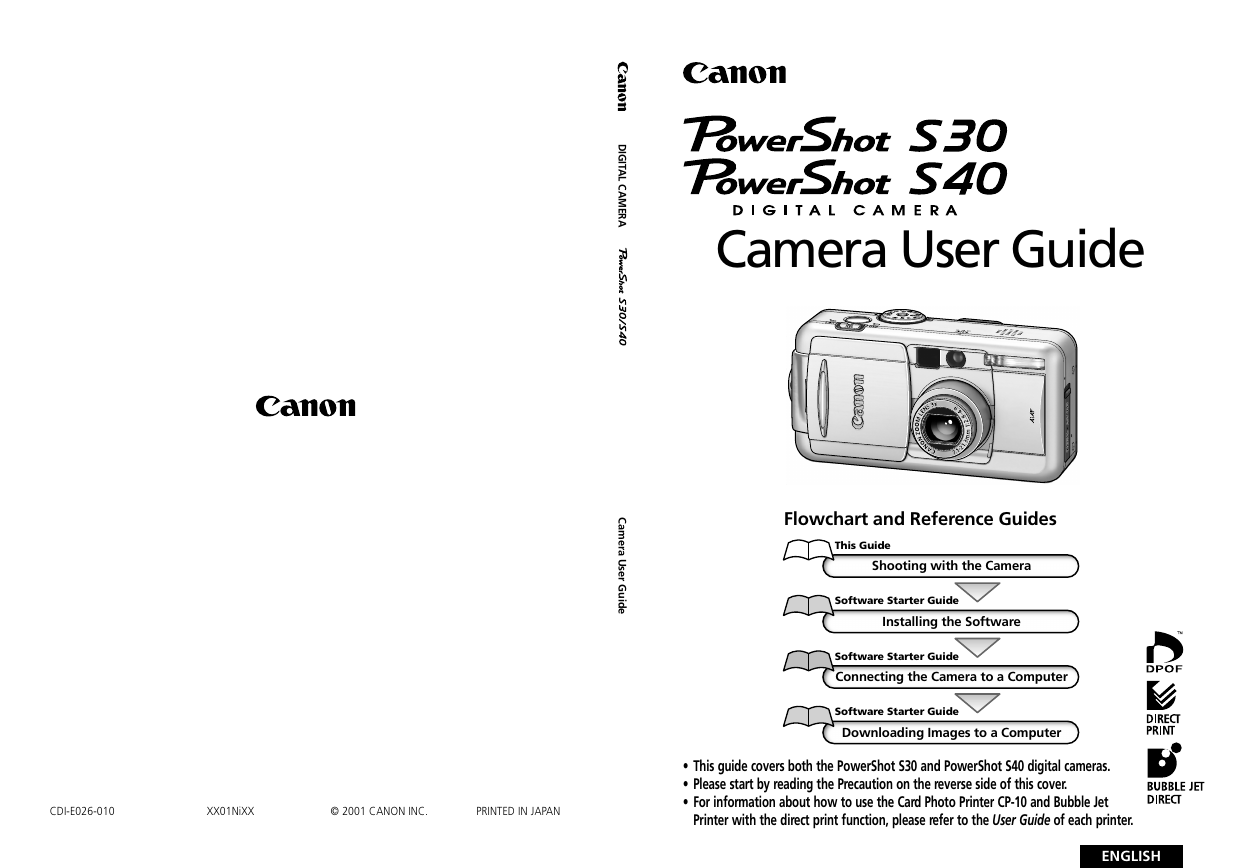

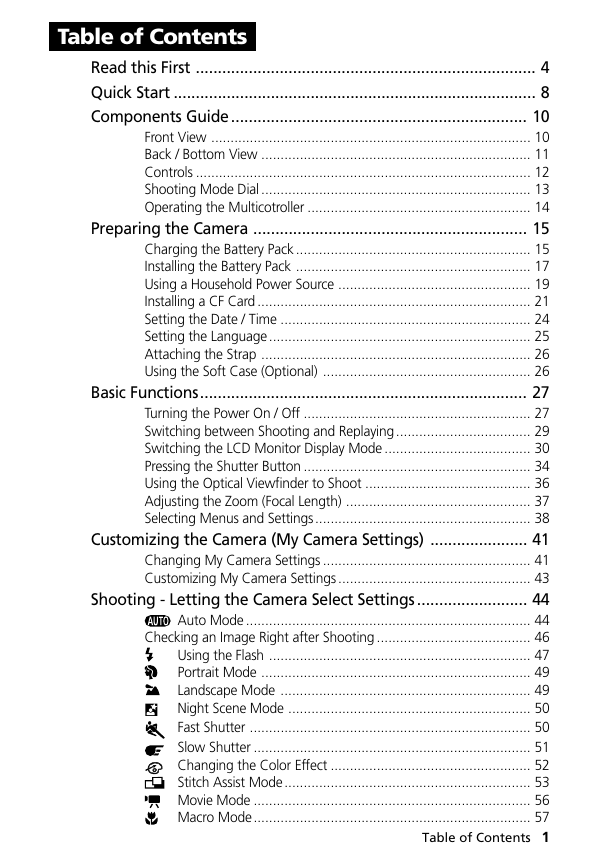
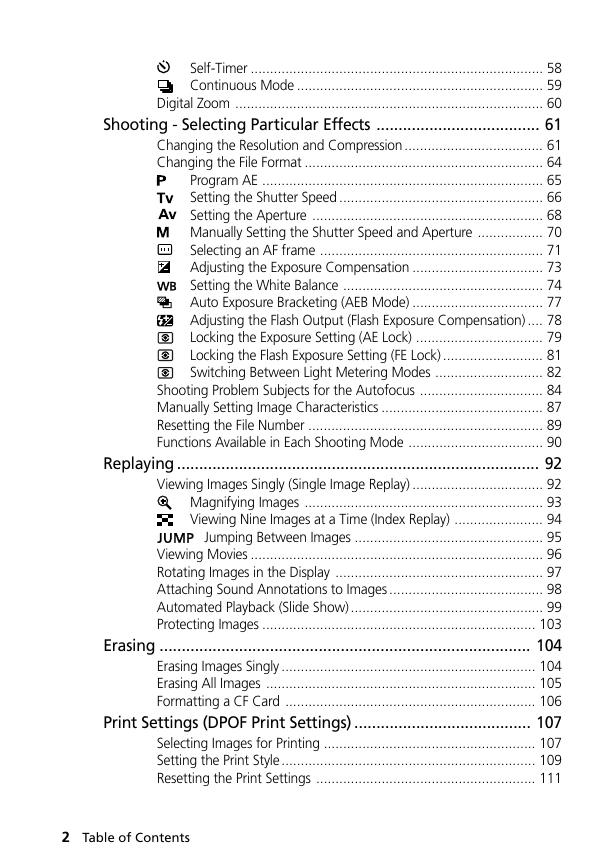
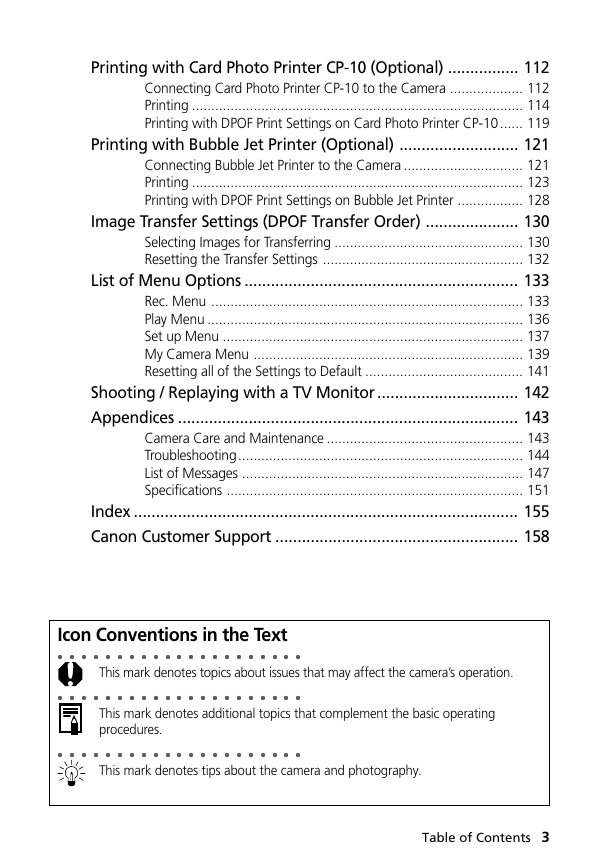
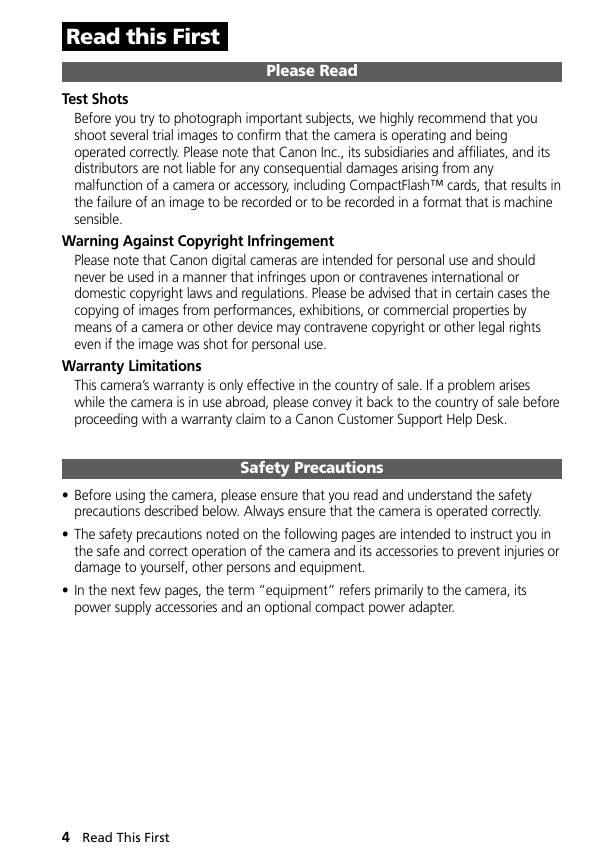
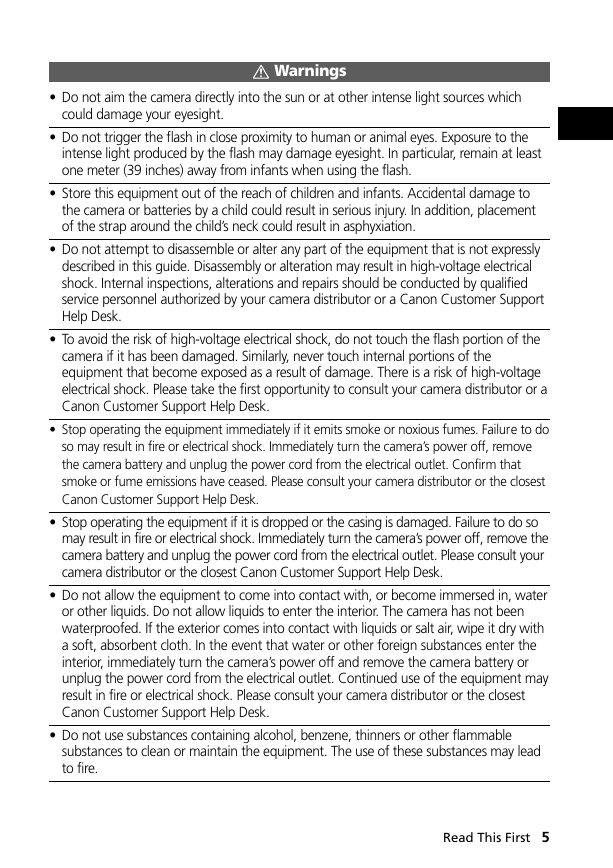
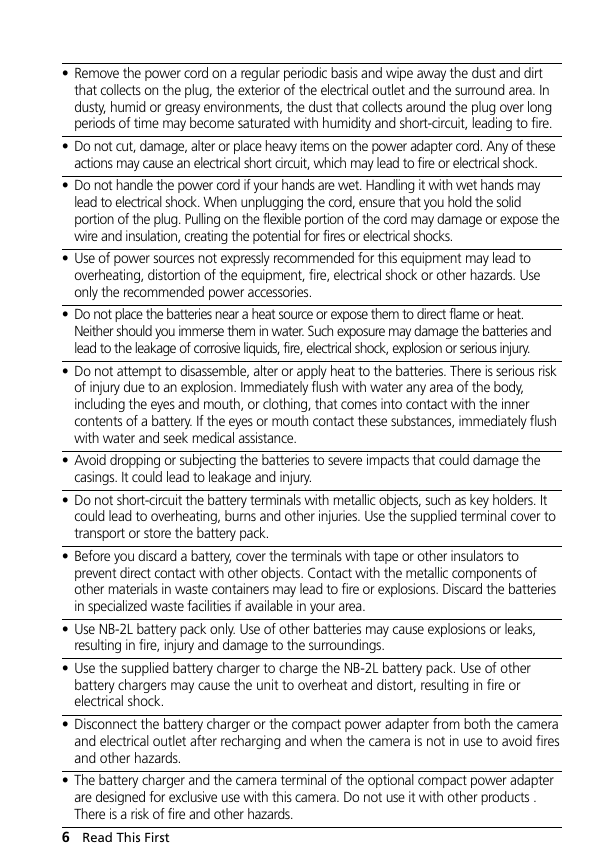








 2023年江西萍乡中考道德与法治真题及答案.doc
2023年江西萍乡中考道德与法治真题及答案.doc 2012年重庆南川中考生物真题及答案.doc
2012年重庆南川中考生物真题及答案.doc 2013年江西师范大学地理学综合及文艺理论基础考研真题.doc
2013年江西师范大学地理学综合及文艺理论基础考研真题.doc 2020年四川甘孜小升初语文真题及答案I卷.doc
2020年四川甘孜小升初语文真题及答案I卷.doc 2020年注册岩土工程师专业基础考试真题及答案.doc
2020年注册岩土工程师专业基础考试真题及答案.doc 2023-2024学年福建省厦门市九年级上学期数学月考试题及答案.doc
2023-2024学年福建省厦门市九年级上学期数学月考试题及答案.doc 2021-2022学年辽宁省沈阳市大东区九年级上学期语文期末试题及答案.doc
2021-2022学年辽宁省沈阳市大东区九年级上学期语文期末试题及答案.doc 2022-2023学年北京东城区初三第一学期物理期末试卷及答案.doc
2022-2023学年北京东城区初三第一学期物理期末试卷及答案.doc 2018上半年江西教师资格初中地理学科知识与教学能力真题及答案.doc
2018上半年江西教师资格初中地理学科知识与教学能力真题及答案.doc 2012年河北国家公务员申论考试真题及答案-省级.doc
2012年河北国家公务员申论考试真题及答案-省级.doc 2020-2021学年江苏省扬州市江都区邵樊片九年级上学期数学第一次质量检测试题及答案.doc
2020-2021学年江苏省扬州市江都区邵樊片九年级上学期数学第一次质量检测试题及答案.doc 2022下半年黑龙江教师资格证中学综合素质真题及答案.doc
2022下半年黑龙江教师资格证中学综合素质真题及答案.doc